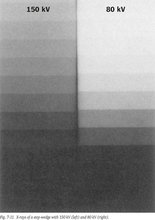Image
Image

Eyebrow
Blog
What is radiation hardness and film contrast?
In this article:
- Radiation Hardness Refers to X-Ray Penetration Power: It is defined by the half-value thickness (HVT)—the material thickness required to reduce radiation intensity by half. Higher radiation hardness means greater penetration and higher HVT
- Increased Radiation Hardness Reduces Image Contrast: As radiation energy increases, the ability to distinguish between different material thicknesses decreases, resulting in lower contrast on radiographic film
- Film Contrast Depends on Radiation Energy and Material Differences: Lower-energy (softer) radiation produces higher contrast images, especially in areas with small thickness variations, as shown in step-wedge comparisons
- Optimal Contrast Requires Balancing Energy and Object Geometry: Selecting the appropriate radiation hardness is critical to achieving sufficient contrast without over-penetrating or underexposing the object
- Tables and Visuals Help Determine Ideal Exposure Settings: Reference tables for steel and lead, along with radiographic images, illustrate how different energy levels affect contrast and guide radiographers in choosing optimal parameters
What is radiation hardness and film contrast?
When radiation hardness increases, the half-value thickness (HVT) also increases. Tables 2-2 and 3-2 for steel and lead respectively show this in figures.
This is why in an object with different thicknesses, image contrast diminishes when radiation hardness increases. Figure 7-11 clearly illustrates this.
The left side of a step-wedge is radiographed with 150 kV, the right side with 80 kV. The right side shows the greater contrast between two steps, whereas on the left the contrast range is the biggest.

